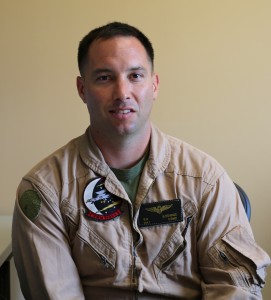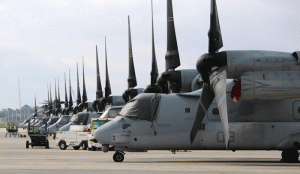2013-07-31 Recently, the pilots of an Osprey team have been awarded the Distinguished Flying Cross for surviving under combat fire. This recognition is for the role of the Osprey in assault missions and is itself a measure of the maturing of the system and its crews in combat.
The two Osprey pilots are the recipients of the first Distinguished Flying Crosses along with their Air Crew, which received Air Medal honors for their performance in Afghanistan.
This is the first time pilots of an Osprey have received the Distinguished Flying Cross.
A USMC news release summarized the award, but really did not tell the story.
Maj. Gen. Robert F. Hedelund, 2nd Marine Aircraft Wing commanding general, presented Marines from Marine Medium Tiltrotor Squadron 365 with two Distinguished Flying Crosses and five Air Medals in their hangar aboard Marine Corps Air Station New River, June 28.
The Marines were awarded for the bravery and courage shown during a mission to insert a reconnaissance raid force into a heavily-defended enemy landing zone in Afghanistan in June 2012.
This is the first time Marine Corps MV-22B Osprey pilots have been awarded the Distinguished Flying Cross.
In this discussion with Major Hutchings, we focused on the events involved in his Osprey coming under battlefield fire in performing its assault mission role.
SLD: Talk about your deployments to Afghanistan.
Major Hutchings: I’ve deployed multiple times to Afghanistan.
The first time was in the summer of 2010, and that was a seven-month tour. We were the second V-22 squadron over there replacing the first Osprey Squadron in theater.
https://sldinfo.com/the-osprey-in-afghanistan-a-situation-report/
https://sldinfo.com/going-to-afghanistan-the-osprey-squadron-prepares/
And then, had a year back at home and then redeployed to Afghanistan again in January of 2012 for seven months.
These were two completely different deployments.
The joke was that the last deployment was not the GS deployment, the GS being the general support mission where all you do is go from FOB to FOB. Earlier we were basically making logistics runs.

SLD: On this second deployment, your primary mission was an assault mission.
Major Hutchings: Assault mission, full up. In our assault role, we are working closely with the other elements of USMC aviation. We worked closely with Hueys and Cobras, and on occasion with the British as well. The latter was a bit challenging because our doctrines and terminology is a bit different.
The mission would be built around a CONOPS approach. And every CONOPS brief had a timeline slide. For multiple missions we would do the assault with 53s and Ospreys. It could be say, a section of 53s or three Ospreys going to the same objective area with skids in the overhead providing the escort piece.
With regard to the timeline, the 53s or skids would take off first. We would take off up to an hour later, and be back an hour earlier than everyone else from the mission.
With the 53s, you can hear them coming for miles ahead. It is moving slower and lower.
With the Osprey, no one can hear us or see us, and drop down in there right at the very end. That’s the plain and distinct advantage we have over those guys.
SLD: What are the main threats you faced when flying?
Major Hutchings: The main threat in Afghanistan is small arms. So, you stay roughly out of small arms range.
Because the Osprey maneuvers like a plane and flies at different speeds than the skids, it complicates the ability of the Taliban to target an entire assault package coming in.
The training wheels were off of the Osprey, and by the end of my time during my second deployment we were doing 9-10 named missions per week.
SLD: Could you discuss the events surrounding the Taliban attack on your Osprey, which damaged the aircraft, and then you had to fight your way back home? In other words, could you talk about the operation, which was recognized by the Distinguished Flying Cross?
Major Hutchings: We had an a.m. crew and a p.m. crew. The a.m. crew was from 01 to 1300, and basically was split into pods and crew chiefs and half, and the afternoon crew started at 1300, went to 01.
This provided a max amount of flexibility for the ground forces to do missions prior to sunrise, and after the sunset.
All of the inserts and extracts will go prior to BNMT, which is before the sun comes up. Or after the sun goes below 12 degrees, below the horizon, so it’s completely black.
We planned for a two Osprey insert of ground troops to do a reconnaissance mission. You never know how hostile the territory will be when you engage. With the Taliban it is like the Whack-a-Mole game.
The landing areas were two sides of a river, and we were to do two inserts of Marines. The first insert came off without a hitch.
It was different the second time in. Of course, we never land using the same landing pattern, but the territory was bit constrained so your options were limited for landing areas.
We were landing at night and as you land you are focusing on the terrain and navigating through the brownout challenges. You tend to be heavy, because they are always cramming the next guy or support gear.
So what are the pucker factors coming in to land?
The first pucker factor is flying low over the mountains in the dark. The second pucker factor is the actual landing. The third is making sure we had a enough gas to get home. If not you have to plan for an alternative site for landing on return.
We started taking fire from the ground. You could hear the bullets hitting the airplane, ting, ting, ting, ting, ting.
By this point, we’re committed to the landing because we’re in the dust.
We continue to take rounds coming in. RPGs come through in the dust. The fuel lines are hit; the ramp will not open. The machine gun jams at the rear of the plane. The brakes don’t work and other things cascade as well.
The guys start jumping out of the back.

After the landing, the gauges tell us not to fly and the condition of the aircraft is such if that we were at an airfield we would have not flown the aircraft. Upon takeoff , we conducted controllability checks and the gearboxes are getting hot as well.
We can’t raise the gear because the hydraulic system blew out.
We were flying in airplane mode with 40 miles to get to Camp Bastion.
The copilot (Dave Austin) suggested that we land on a ramp at Camp Bastion because our brakes were not working.
They brought out a tug to bring the aircraft in and after we got out we could see the plane was riddled with ground fire.
We were safe but our thoughts were off Captain Haake’s plane and concerned about his fate. Later we learned, that he too had taken ground fire and had to land at the FOB rather than making it back to Bastion.
With regard to the Osprey, our experience shows that it is a tough bird. And it’s proven that it can take rounds of critical flight components and keep on flying.
The redundancy built into the aircraft is crucial. The redundancy works.
As long as the engines are spinning and the wheels are turning, it’s going to make it somewhere.
See also the following stories:
http://breakingdefense.com/2013/07/31/maturing-of-the-osprey-first-v-22-pilots-awarded-dfcs/
https://sldinfo.com/captain-haake-on-osprey-afghan-operations-the-osprey-under-fire/
https://sldinfo.com/the-first-osprey-pilots-receive-the-distinguished-flying-cross/
Our latest book focusing on the evolution of USMC combat approaches enabled by the evolution of USMC aviation and new navy ships can be purchased from several e-book publishers including the following:
http://www.scribd.com/doc/155441562/Three-Dimensional-Warriors-Second-Edition

